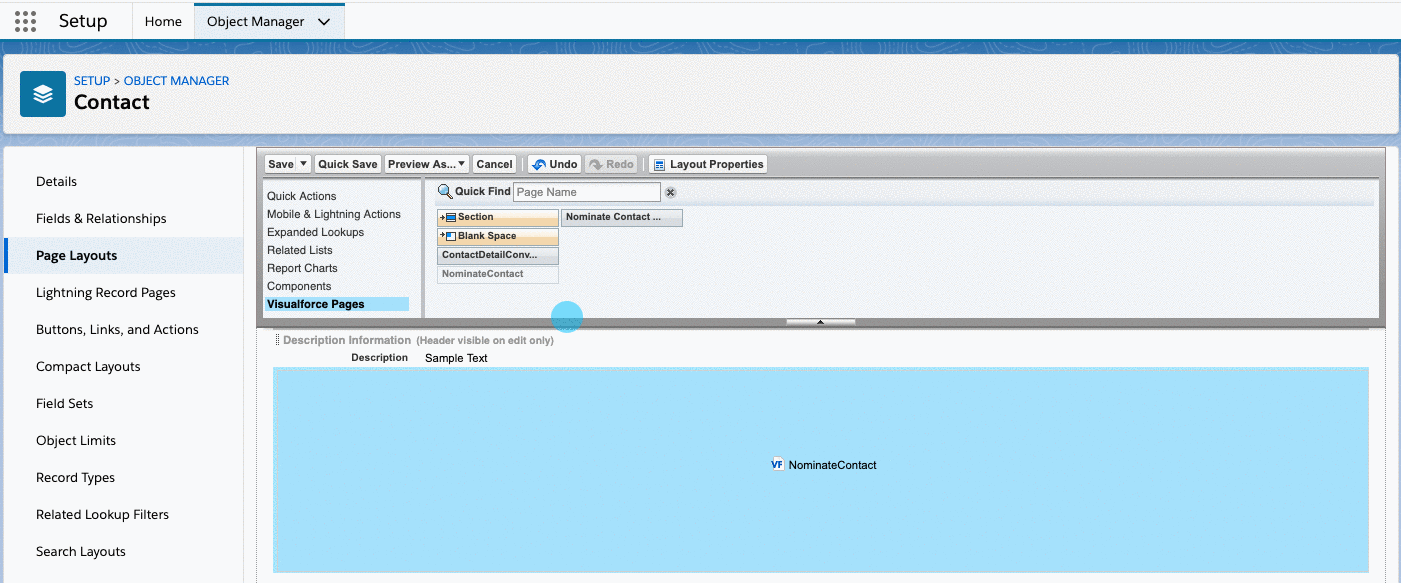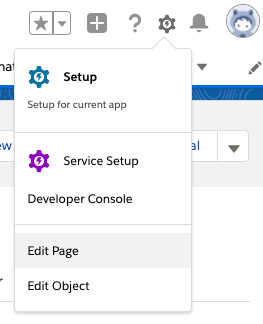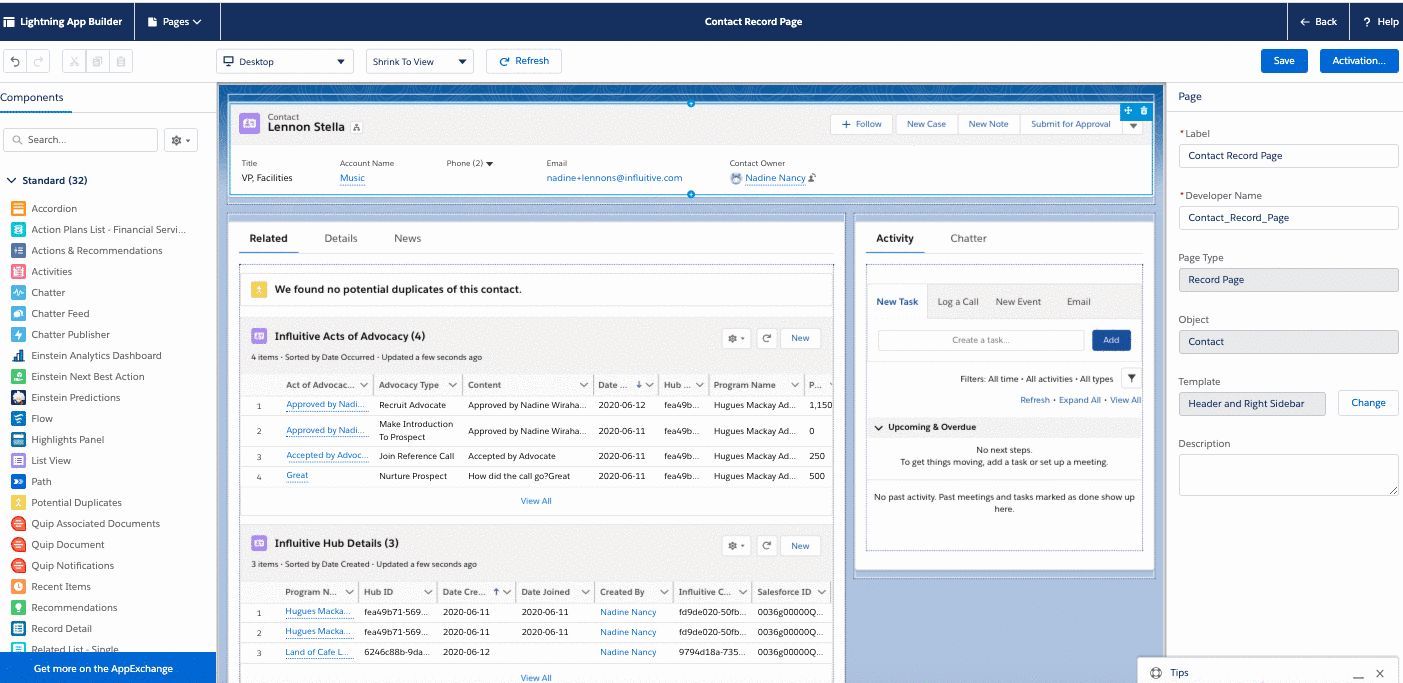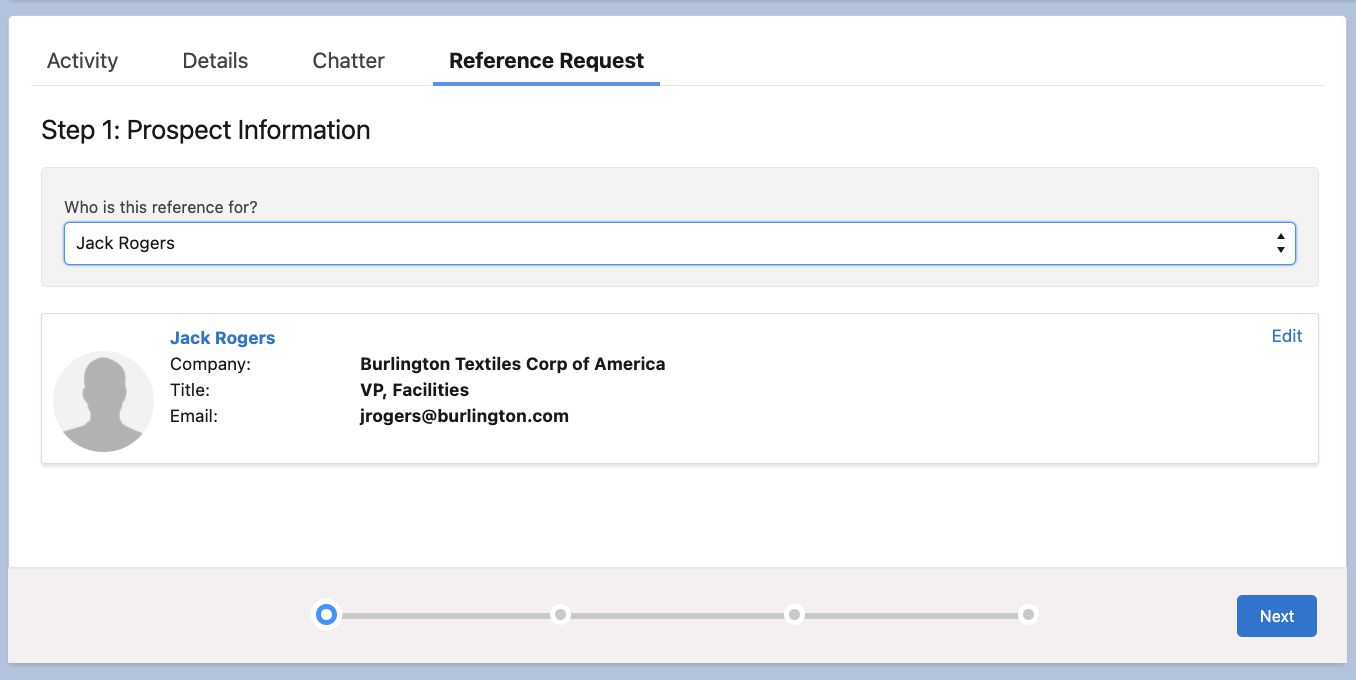Salesforce Lightning: Package Install 3.529
Package Install instructions from 1.12 or 1.15 to 3.529 for Salesforce Lightning version
This article will cover the following topics:
About AdvocateHub Salesforce Package 3.529
This AppExchange Package is the newest and latest version (Version 3.5) and it includes the following items:
- Compatibility with Salesforce Lightning and Salesforce Classic
- Improved Nomination button tool and MultiHub support
- Improved Reference Request tool and MultiHub support
- New Acts of Advocacy Object and MultiHub support
- New Salesforce Dashboard Reports
- Consistent labels and naming for the components
Installing the Influitive AppExchange Package 3.529
AppExchange Package Link
- Login to your salesforce.com account as a Salesforce administrator.
- Open a new tab and click on the following link to install the following package:
Select Install for All Users and click Install or Upgrade.

You will be prompted to approve a third-party access. Mark the checkbox and click Continue. This is needed for your Salesforce to be able to connect to the Influitive Hub.

- Once Installation is completed, you will see the completion message or email. Login to your Salesforce to check if the package version (Setup > Platform Tools > Installed Packages > Package Name: AdvocateHub > Version Number 3.+).
Notes:
- If you wish to install the AppExchange package to a Sandbox instance, make sure that you are signed into the Sandbox instance before clicking on the link to install (as per Point 2 above). Otherwise, it will install to your Production instance.
- We are currently applying to be a member of the Salesforce AppExchange Partner program. Therefore, please mark the acknowledgment checkbox to install the new package in the meantime. We thank you for your understanding.
Connect Salesforce Environment and the Hub
After the AppExchange package is installed, a Salesforce user would need to input their Salesforce username, password, and security token into your AdvocateHub to connect the instances together.
- In the AdvocateHub, click on the Gear icon in the top right corner of the screen and click on Integrations to go to the integration library.

- Browse through the integration library until you find the Salesforce integration and click Manage.

- To enter your credentials, navigate to the Setup Tab and click Authenticate to start and you will see the following page. You can choose to authenticate via the Standard password and username method or the OAuth Login method:

- Choose the Target Environment for the Salesforce instance you're connecting, either Production or Sandbox instance. It is currently not possible to connect to both instances at the same time. However, you may switch the instance and re-authenticate at any time.
- Next, if you are using the Standard method, enter the Username, Password, Token and Organization ID associated with your Salesforce account. Please make sure the Organization ID is correct and that the connected integration user has the following Salesforce: Required Field Permissions:
- How to find your Token: Go to Settings on Salesforce under your Admin avatar > Reset My Security Token > Click on the Reset Security Token button. You will be sent an email to your inbox containing the token.


- How to find your Organization ID: To find Organization ID, go to Salesforce Setup > In the Quick Find Search, type Company Information.

- How to connect without a token:
- Login to Salesforce and go to Setup > Security > Network Access.
- Add Influitive’s IP address (contact support@influitive.com to acquire the IP address) to the list of trusted IP addresses. It can be both the start and the end of the range.
- Return to the Salesforce integration in the AdvocateHub and enter your credentials (without the token).
- You may get an error message the first time you save your credentials in the hub as our system is still communicating with SFDC to figure out the connection. If so, please try again and give it a few minutes to authenticate.
- How to find your Token: Go to Settings on Salesforce under your Admin avatar > Reset My Security Token > Click on the Reset Security Token button. You will be sent an email to your inbox containing the token.
- Under App Exchange Version, please select version 3.5. Once all the data is confirmed, please hit Save to authenticate the integration.
- If you run into any issues or received any error messages, please consult our Salesforce Errors and Troubleshooting documentation. If you can't find the answer to the issue, please take a screenshot of any error messages you've received and send an email to support@influitive.com.
Influitive Hub Mappings
Next, you will need to add Hub Mappings to connect the Hub.
Hub Mappings Menu
- Once logged in to your Salesforce, head over to any Contacts Page. Or search in App Launcher > Hub Mappings.
- Click on the pencil icon on the navigation menu to "Personalize your nav bar"

- In the Edit Sales App Navigation Items > click Add More Items

- Then Search for Hub Mappings > Click on the Plus sign > click Add Nav Items

- The Influitive Hub Mappings Menu is now on your Navigation menu.

Add AdvocateHub to Influitive Hub Mapping
- Once the menu is added, click on the Hub Mappings menu from the Navigation tab
- Click on the New button

- Enter your Influitive Hub Program Name under Program Name field. This is so that each Advocacy event can be identified by which Hub it occurred in.

- For Hub ID, this information is available on your AdvocateHub. Sign in to your admin account in the AdvocateHub > Click on the gear icon > Integrations > Influtive API > Manage > Click the Setup Tab > Copy the number string from X_ORG_ID.

- Paste in on the Influitive Hub Mapping sunder Influitive Hub ID field and click Save
- To recap:
Influitive Hub Mapping Name: Please enter the Name of your Hub Program
Influitive Hub ID: The X ORG ID Number provided in Influitive API
Influitive Hub Domain: Please enter the URL of the Advocatehub (e.g. https://hub.influitive.com) -
 For Multiple Hubs, you will need to add all the Hub Mappings for each Hub. More on MultiHub CRM Setup.
For Multiple Hubs, you will need to add all the Hub Mappings for each Hub. More on MultiHub CRM Setup.
Adding Components in the Page Layouts
After installing and deploying the AppExchange package, the Salesforce administrator will need to modify a few object layouts to add the Influitive integration components.
For further information on modifying Salesforce Page Layouts, please visit this Salesforce Help Page.
Page Layout Checklist
| Objects | Components |
| Contacts |
|
| Account |
|
| Opportunity |
|
Layout Changes Checklist
- Contacts Object Layout
- Removing old Nominate Now button & Adding the new Nominate Now button
- Removing Advocacy Activities & Adding Acts of Advocacy
- Removing Advocacy Activities (Prospect) & Adding References Given
- Account Object Layout
- Adding Influitive Acts of Advocacy component
- Adding References Related Activities List
- Opportunity Object Layout
- Adding the New Reference Request Tool
- Adding the References Received via Influitive related list
- Salesforce Report Dashboard
- Remove the old Influitive Dashboard to make space for Influitive Dashboard 3.0.
Contacts Page Layout
To start, go to Contacts > Select a contact record > Click on the Gear icon > Edit Object > Page Layout > Select the Layout to change.

A. Removing the old Nominate Now Button if you have the component
Search for the "Nominate Contact" component on the Contacts Page Layout > Click the Remove icon.

B. Adding the new Contact Converted Detail (The new Nominate Now Button for Lightning)
This widget will outline the Contact details in the Hub (e.g. email, Current Points, Lifetime Points, Nominated By).
- On the same page > Select VisualForce Pages > Drag ContactDetailConverted to the area that you prefer.
Then click on the Wrench icon on the component > Increase the size to 400 (optional) > Add the Scrollbar option.

Additionally, you can head over to a Contact record > Click the gear icon > Edit Page

- Drag and Drop Custom Managed Component - ContactDetailComponent to the Contact record Area
It may take some time to load but once it load, click Save.

C. Removing the old Advocacy Activities Object if you have the component
On the same page, scroll down the page to find the AdvocacyActivities object in the Related Lists > Click Remove icon.

D. Adding the new Influitive Acts of Advocacy Object
This custom object will list all the acts of advocacy activities that the contact completed in the Hub.
- On the same page > Select Related Lists > Drag and drop Influitive Acts of Advocacy to the area that you prefer.

- Once added, click on the wrench icon. In this window, please add the following fields to display in the Acts of Advocacy Object. Click OK once you're done.
- Acts of Advocacy Name (Required) - This describes the act of advocacy completed by the advocates.
- Advocacy Type - https://support.influitive.com/article/619-acts-of-advocacy-types-and-reporting-category
- Source Title - This would be the challenge's name where the act of advocacy came from.
- Date Occurred - This is the date and time the act of advocacy occurred in the Hub.
- Content - The Challenge or Discussions responses content
- Prospect - If you are using the Reference request tool, this column will show the prospect's name that the contact completed a reference for from the Hub. If you are not using the Reference Request tool, you may skip adding this field column.
Please Sort By: Date Occurred (Descending)

- Click OK and click Save to save the changes to the Layout.
- Once saved, try and search for a Contact record > Click the gear icon > Edit Page

- Click on the Related List area where you've placed the Acts of Advocacy Component > On the right hand side of the screen, under Related List Type > Enhanced List. This will display the columns that you've selected. Click Save once you're done.


-
Once done, it should look like this when there are Hub activities pushed to Salesforce. To backfill the past Hub activities to the new component, please see Influtiive Acts of Advocacy: Backfill.

E. Removing the old Advocacy Activities (Prospect) Object if you have the component
- On the same page, scroll down the page to find the AdvocacyActivities (Prospect) object in the Related Lists if it's available > Click on the Remove icon.

F. Add References Received via Influitive Object
This custom object will list all the reference request challenges that the contact has completed. This is related to the Salesforce: Reference Request feature that is an additional fee. If you don't have this tool in your contract, please skip this step.
- In the same page > Select Related Lists > Drag and drop References Received via Influitive to the area that you prefer.

- In this window, please add the following fields to display in the Acts of Advocacy Object. Click OK once you're done.
- Acts of Advocacy Name (Required) - This describes the act of advocacy completed by the advocates.
- Advocacy Type - https://support.influitive.com/article/619-acts-of-advocacy-types-and-reporting-category
- Source Title - This would be the challenge's name where the act of advocacy came from.
- Date Occurred - This is the date and time the act of advocacy occurred in the Hub.
- Contact - This field will show which Salesforce contact (Hub member) that completed the reference request challenge for this Salesforce prospect contact.
- Content - The Challenge or Discussions responses content.
- Program Name - This will show the name of the Hub where the activity happens.
Please Sort By: Date Occurred (Descending)

- Click OK and click Save to save the changes to the Layout.
Accounts Page Layout
To start, click Setup > Customize > Accounts > Page Layouts > Click Edit next to the layout that your Salesforce users use. The following components are provided from the AppExchange Package:
A. Adding the new Influitive Acts of Advocacy Object
This custom object will list all the acts of advocacy activities that the contacts in the Account have completed in the Hub.
- On the same page > Select Related Lists > Drag and drop Influitive Acts of Advocacy to the area that you prefer.

- Once added, click on the wrench icon. In this window, please add the following fields to display in the Acts of Advocacy Object. Click OK once you're done.
- Acts of Advocacy Name (Required). This describes the act of advocacy completed by the advocates.
- Advocacy Type - https://support.influitive.com/article/619-acts-of-advocacy-types-and-reporting-category
- Contact - This is the contact record the completed the acts of advocacy.
- Source Title - This would be the challenge's name where the act of advocacy came from.
- Date Occurred - This is the date and time the act of advocacy occurred in the Hub.
- Content - The Challenge or Discussions responses content.
- Prospect - If you are using the Reference request tool, this column will show the prospect's name that the contact completed a reference for from the Hub. If you are not using the Reference Request tool, you may skip adding this field column.
Please Sort By: Date Occurred (Descending)

- Click OK and Click to save the changes to the Layout.
- Once saved, try and search for an Account record > Click the gear icon > Edit Page

- Click on the Related List area where you've placed the Acts of Advocacy Component > On the right-hand side of the screen, under Related List Type > Enhanced List. This will display the columns that you've selected. Click Save once you're done.

-
Once set, it should look like this when there are Hub activities pushed to the Salesforce component. To backfill the past Hub activities to the new component, please see Influtiive Acts of Advocacy: Backfill.

B. Adding the References Received via Influitive Component
- Go back to Object Manager > Account > Lightning Record Pages > Choose a layout
Once you’re in the Lightning app builder > on the left menu, scroll down to Custom - Managed components > Select ReferencesRelatedListCmp and drag it to the layout

- Select the Related list section and on the right side of the page select Enhance List.
- Click Activation and Save.
This will be the new Related List Component that will record the reference activities for the selected Prospect’s Account and the Influitive Acts of Advocacy of the Hub member’s Salesforce Account.

Opportunity Page Layout
A. Reference Request Tool (Compatible with Lightning)
Note: This tool is used to create reference requests challenges in the AdvocateHub. The Request a Reference component should only be added to the Opportunity object. It will not work on any other Salesforce object type. This Reference Request feature may be an additional cost, please contact your CSM to confirm.
- Go to the Opportunities tab and select an Opportunity record.
Click on the Gear and select Edit Page option.

Create a new tab for Request a Reference

Put RequestReferenceComponent to the tab

Click Save. You may need to wait a few minutes for the Preview to load. Once loaded, check the Opportunity Record to see the changes you've made.

- All done! To see the Hub members and Reference requestor experience on using the Reference Request Feature as well as the best practice for this feature, please follow the following article - Salesforce: Reference Request
If you like to add the Reference Request tool as a button in Salesforce, please see this article: How to add Reference Request Converted as a button in Salesforce.
C. Remove the old Reference Request Tool
- Go to Object Manager > Opportunity > Page Layout > Select Layout
Under Custom Buttons > Drag the Reference Request button out of the layout to remove it

- Click Save to save the layout.
C. Adding References Received via Influitive Table
- Go to Object Manager > Opportunity > Page Layout > Select Layout
- In the Related List > Drag and drop References Received via Influitive into the Layout
- Click on the wrench icon and add the following fields: Acts of Advocacy Name (Required), Advocacy Type, Source Title, Date Occurred, Prospect, Content, Opportunity, Prospect.
- Click Save Layout
Here's an example of what this looks like. This component will include all reference activities the Opportunity has received.

Salesforce Influitive Dashboard
- Head over to the Dashboard > Dashboard List
- Remove the other Influitive Dashboards, there should only be one dashboard: Influitive Dashboard 3.0
- Please note that when you delete a Dashboard, all the customizations done in that report will be deleted as well.

Salesforce-Influitive Individual Feature Setup Update
Please continue the setup update on the Influitive Integration by going through the following articles for the Salesforce integration features:
















 For Multiple Hubs, you will need to add all the Hub Mappings for each Hub. More on
For Multiple Hubs, you will need to add all the Hub Mappings for each Hub. More on 






















